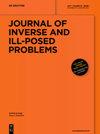Boundary determination for hybrid imaging from a single measurement
IF 0.9
4区 数学
Q2 MATHEMATICS
引用次数: 0
Abstract
We recover the conductivity σ at the boundary of a domain from a combination of Dirichlet and Neumann boundary data and generalized power/current density data at the boundary, from a single quite arbitrary set of data, in AET or CDII. The argument is elementary, algebraic and local. More generally, we consider the variable exponent通过一次测量确定混合成像的边界
我们从 AET 或 CDII 中的一组相当任意的数据中,结合 Dirichlet 和 Neumann 边界数据以及边界处的广义功率/电流密度数据,恢复域边界处的电导率 σ。论证是基本的、代数的和局部的。更一般地说,我们将可变指数 p ( ⋅ ) {p(\,\cdot\,)} - 拉普拉斯视为一个前向模型,其内部密度数据为 σ | ∇ u | q {\sigma|\nabla u|^{q}} ,并发现单次测量就能指定边界的功率/电流密度数据。 并发现当 p - q ≥ 1 {p-q\geq 1} 时,单次测量指定了边界电导率,否则测量指定了两个备选方案。 否则,测量会指定两个备选方案。我们提出了在这些备选方案中进行选择的启发式方法。p 和 q 都可能取决于空间变量 x,但假设它们是先验已知的。我们将用可用代码中的数值示例来说明实际情况。
本文章由计算机程序翻译,如有差异,请以英文原文为准。
求助全文
约1分钟内获得全文
求助全文
来源期刊

Journal of Inverse and Ill-Posed Problems
MATHEMATICS, APPLIED-MATHEMATICS
CiteScore
2.60
自引率
9.10%
发文量
48
审稿时长
>12 weeks
期刊介绍:
This journal aims to present original articles on the theory, numerics and applications of inverse and ill-posed problems. These inverse and ill-posed problems arise in mathematical physics and mathematical analysis, geophysics, acoustics, electrodynamics, tomography, medicine, ecology, financial mathematics etc. Articles on the construction and justification of new numerical algorithms of inverse problem solutions are also published.
Issues of the Journal of Inverse and Ill-Posed Problems contain high quality papers which have an innovative approach and topical interest.
The following topics are covered:
Inverse problems
existence and uniqueness theorems
stability estimates
optimization and identification problems
numerical methods
Ill-posed problems
regularization theory
operator equations
integral geometry
Applications
inverse problems in geophysics, electrodynamics and acoustics
inverse problems in ecology
inverse and ill-posed problems in medicine
mathematical problems of tomography
 求助内容:
求助内容: 应助结果提醒方式:
应助结果提醒方式:


